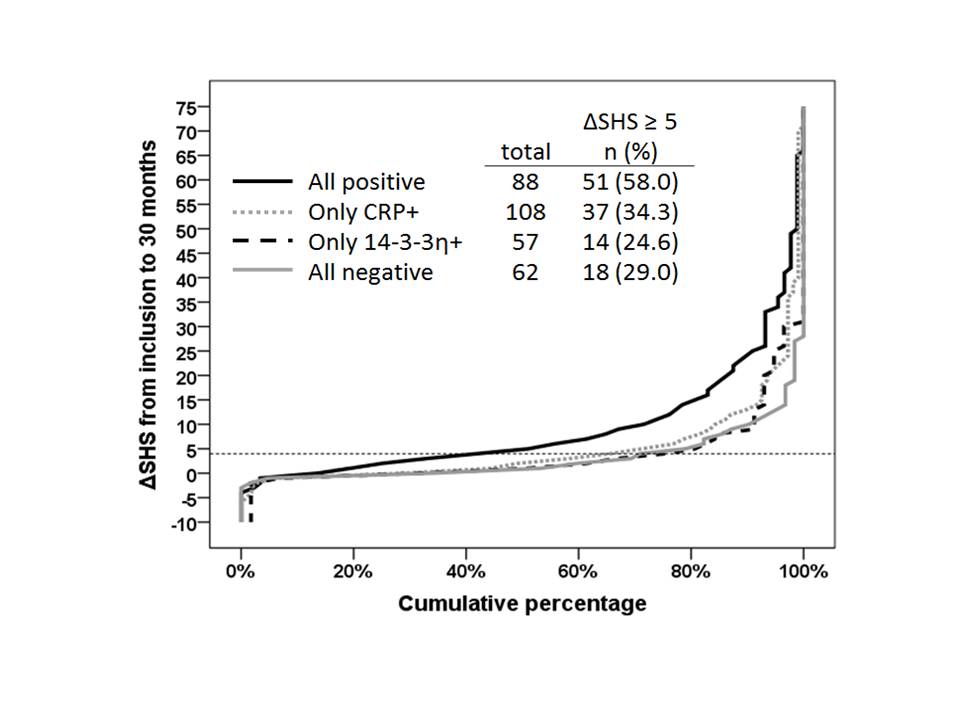Session Information
Session Type: ACR Poster Session C
Session Time: 9:00AM-11:00AM
Background/Purpose: As a marker of inflammation
and
an acute phase reactant, C-reactive protein (CRP) is routinely used in clinical practice and in RA classification criteria.
Higher or sustained levels of CRP are associated with a worse prognosis. 14-3-3η is a joint derived mechanistic marker that up-regulates
factors that perpetuate disease. Similar to CRP, higher or persistent levels of 14-3-3η
are associated with a worse prognosis,
and lower
circulating levels are associated with better clinical
outcomes. Inflammation and joint damage are now understood to be processes that uncouple along the course of disease and
treatment strategies have been tightened to achieve both clinical and joint damage remission. The aim of this study was
to
examine both the
independent and combined effects of CRP and 14-3-3η on radiographic progression.
Methods: Baseline (BL) serum 14-3-3η
titres were assessed in
331 recent onset polyarthritis patients from the Sherbrooke EUPA
Cohort with 5 years of radiographic follow-up data. Patients were DMARD naïve at BL, median age was 60 years, and 62% were
female. CRP and 14-3-3η positivity were defined as >8mg/L and ≥0.19ng/ml, respectively. Spearman correlation was performed to assess the relationship
between 14-3-3η and CRP titres. Radiographic
changes (change in total Sharp/van der Heijde (ΔSHS)
score over 30 months were assessed in relation to CRP and 14-3-3η co-expression using ANOVA analysis.
Chi-square was used to assess
the relationship between CRP positivity with radiographic changes at 30 months based on ΔSHS ≥1, 3, and 5 unit cut-offs.
Results: Of 331 patients, 207 (63%) and 153 (46%) were CRP and 14-3-3η positive at BL, respectively.
Spearman correlation revealed that titres of CRP and 14-3-3η did not correlate, r= -0.00025
p=0.996. As noted in Table, Chi-square analysis returned
both CRP and 14-3-3η as significantly associated with radiographic changes.
|
|
ΔSHS BL to Year 3 ≥ 1 n = 233 |
ΔSHS BL to Year 3 ≥ 3 n = 168 |
ΔSHS BL to Year 3 ≥ 5 n= 120 |
|||
|
Variable |
OR |
p-value |
OR |
p-value |
OR |
p-value |
|
CRP positivity |
1.73 |
0.034 |
2.47 |
<0.001 |
2.22 |
0.001 |
|
14-3-3η positivity |
1.69 |
0.046 |
1.74 |
0.016 |
1.70 |
0.023 |
|
CRP and 14-3-3η positivity |
2.82 |
0.002 |
3.68 |
<0.001 |
3.16 |
<0.001 |
The cumulative probability plot
illustrates that patients who
were positive for both CRP and 14-3-3η
had
the significantly
greatest increase in radiographic
progression (p<0.001) with over 50% of patients having ΔSHS≥5 over the 30 month period.
Conclusion: CRP and 14-3-3η are both associated
with joint
damage progression at 3 years and titres do not correlate
consistent
with their distinct roles in RA disease processes. Interaction analysis further reveals that the combination
of these two markers is a better predictor of future radiographic damage than either marker alone. Concomitant serial testing of
both these modifiable
markers may assist with tight control RA treatment strategies.
To cite this abstract in AMA style:
Boire G, Carrier N, de Brum-Fernandes A, Liang P, Masetto A, Gui Y, Savill J, Michienzi S, Ménard H, Maksymowych W, Marotta A. CRP and 14-3-3η Are Each Associated with Joint Damage Progression, Their Titres Do Not Correlate and Are Better Predictors of Progression Together Than Alone [abstract]. Arthritis Rheumatol. 2015; 67 (suppl 10). https://acrabstracts.org/abstract/crp-and-14-3-3-are-each-associated-with-joint-damage-progression-their-titres-do-not-correlate-and-are-better-predictors-of-progression-together-than-alone/. Accessed .« Back to 2015 ACR/ARHP Annual Meeting
ACR Meeting Abstracts - https://acrabstracts.org/abstract/crp-and-14-3-3-are-each-associated-with-joint-damage-progression-their-titres-do-not-correlate-and-are-better-predictors-of-progression-together-than-alone/

